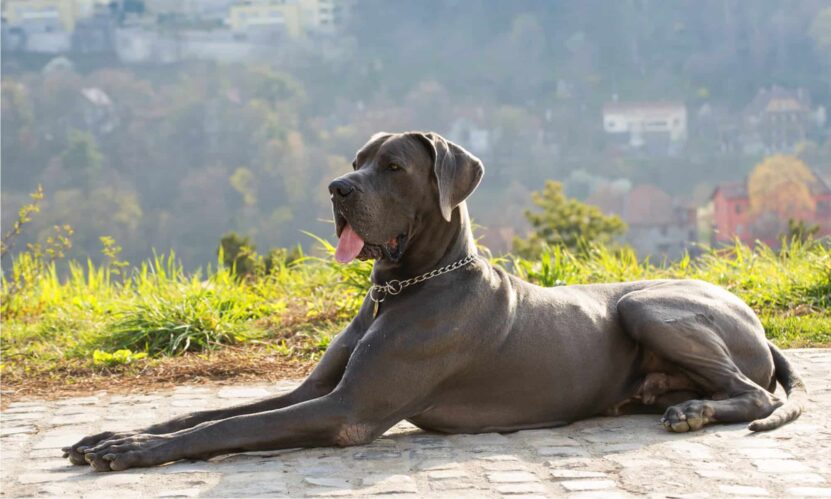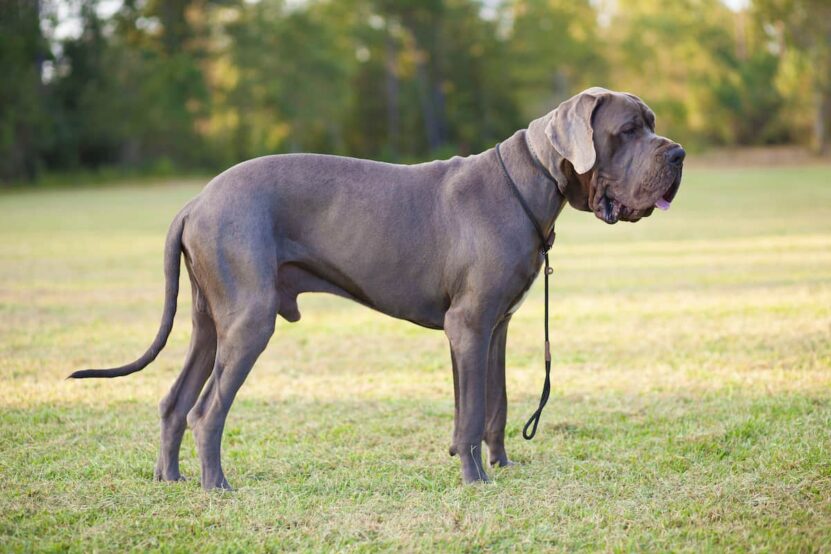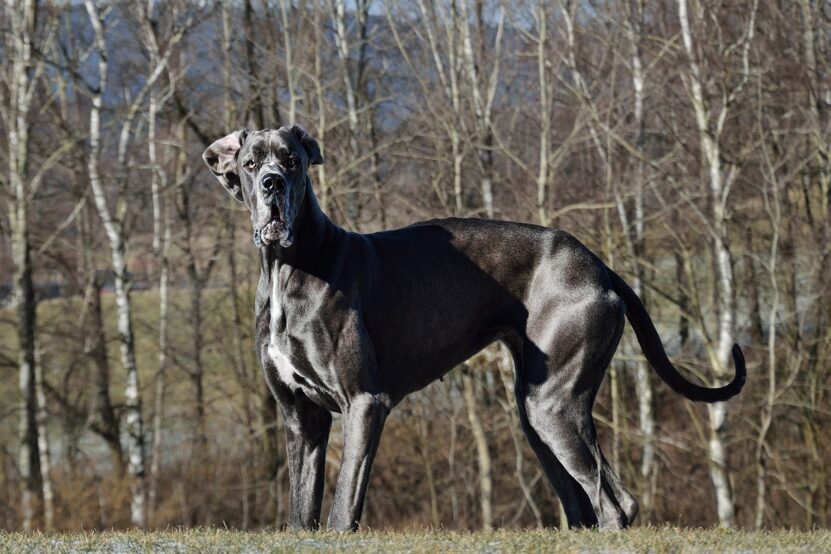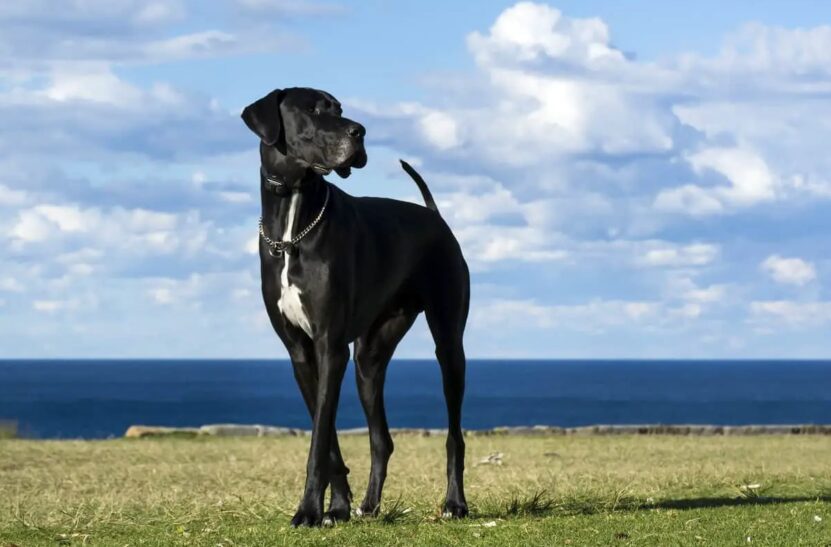There are several varieties of dogs, and they are all considered to be man’s best friend. The Great Danes are one of a select few breeds that are both exceptional and courteous and royal-looking.
One of the most beautiful and royal dog breeds in the world is the Great Dane, sometimes known as the “gentle giant.” These remarkable canines, known for their enormous size and kind disposition, have won the hearts of many dog enthusiasts.
Are Great Danes effective security dogs in addition to their outstanding looks and loving personalities? This article will examine the traits, background, training potential, and appropriateness of the breed guard dogs.
The Origin and Appearance

The Great Dane, originating from Germany, is a giant dog breed with a commanding presence. Thanks to the patience, good training, and care these exceptional dogs are recognized for their peacefulness, extreme care for children, and nice overall demeanor.
Despite their size, Great Danes have a well-balanced, muscular physique that gives them a beautiful and elegant aspect. They have a broad, square head with a deep nose and warm, intelligent eyes that are expressive.
Great Danes may be traced back to ancient civilizations when early prototypes of these dogs were employed for hunting and guarding duties. This information is important for individuals who are curious about the origins of this breed and how long they have existed.
However, it was in Germany during the 19th century that the breed as we know it today started to take shape.
The Evolution of the Breed
Great Danes were originally used to hunt big wildlife like wild boar. Due to their intimidating size and protective nature, their job gradually changed to estate guarding and property protection.
The English Mastiff and Irish Wolfhound were crossed in the 16th century, creating the “Boarhound” breed. Later, this breed found its way to Germany, where it was improved upon and transformed into the Great Dane that we know today.
The French scientist Buffon is credited with giving these canines the moniker “Grand Danois” in the 18th century, which is where the term “Great Dane” is said to have come from.
The Gentle Giant
Does their size indicate that they are lovely and compassionate or that they may be ferocious? The kind and sociable nature of Great Danes is one of its distinguishing traits. They are recognized for their kind and friendly temperament despite their imposing size, frequently developing close ties with their families.
These canines are noted for being kind and patient, especially around kids, which has earned them the moniker “gentle giants.”
Great Danes are extremely friendly dogs who like being around people. They are great family dogs because of their affable and sociable demeanor.
They are suitable for a variety of living conditions, including homes with children and other pets since they are normally not violent without being provoked and because of their calm and collected demeanor.
Great Danes as Guard Dogs

If you’re wondering whether Great Danes make good guard dogs, we’re here to inform you that they do, even though they are not normally aggressive or territorial canines by nature. They can respond alertly and vigilantly if they sense a threat to their family or home.
Potential intruders are frequently deterred by their enormous stature and intimidating bark. It’s important to remember, though, that they might not have the same level of protective instinct as breeds created especially for guard work.
Great Dane’s Protective Instincts
The protective attitude of Great Danes is more bent towards loyalty and watchfulness than it is towards overt violence. They frequently bark to let their owners know if something is out of the ordinary, although they typically save aggressive behaviors for last.
They can deter trespassers and invaders just by their intimidating presence, but they are often violent for a good cause.
Training and Socialisation of Great Danes
Most people think it’s difficult and practically impossible to educate such large dogs, particularly Great Danes, however, training and socialization are essential for all dog breeds, including Great Danes.
Their protective instincts may be channeled and their behavior can be molded with early and regular training. Due to their stature, early training is extremely crucial to make sure they develop into polite and submissive adults.
Great Danes are extremely trainable due to their intelligence and desire to please. They are best trained using persistent and rewarding approaches because they can be stubborn as well. Harsh training methods are not advised since they might cause fear or hostility in a breed that is naturally kind.
For Great Danes to be at ease and act properly among humans, other dogs, and a variety of settings, socialization is also crucial. Early exposure to various settings, noises, and people will help them develop into self-assured and sociable adults.
The Great Dane as a Deterrent

Due to their size and intimidating bark, Great Danes can serve as deterrents, although they might not make the finest guard dogs. The intense guarding behaviors exhibited by some other breeds may not be appropriate given how amiable and non-aggressive they are.
However, their very presence alone can deter possible attackers, and because they are devoted to their families, they will let you know if anything is out of the ordinary.
The Uniqueness of Every Great Dane
It’s important to keep in mind that each dog’s temperament is different, and some Great Danes may display stronger protective instincts than others. These qualities can be improved by appropriate training and early socialization. However, there are other breeds more suitable for that purpose if you especially need a breed with strong guard dog qualities.
Practical Considerations for Great Dane Owners
There are several practical things to bear in mind while thinking about Great Danes as prospective security dogs. Their enormous size necessitates plenty of room and a comfortable living environment. Great Danes want space to spread out and roam freely, thus they are not suitable for tiny residences or cramped areas.
They also have important demands in terms of exercise. Great Danes need frequent daily exercise to keep them physically and psychologically occupied despite their peaceful attitude inside. For their well-being, long walks, playfulness, and off-leash activities in secure settings are all good.
Due to their size and rapid pace of growth, Great Danes also have particular nutritional requirements. To keep them healthy and happy, they need to eat a balanced, nutritious diet and receive routine veterinarian exams.
Conclusion

As “gentle giants,” Great Danes are renowned for their warmth and friendliness rather than their ability to serve as formidable guard dogs.
Although they may serve as a deterrent to prospective invaders because of their intimidating size and defensive instincts, their natural friendliness and loving nature make them better suited as devoted family pets and attentive defenders.
The Great Dane is a great option if you want a dog that is both lovable and commanding.
Remember that a dog’s suitability as a guard dog, regardless of breed, mostly depends on his or her training, socialization, and unique temperament. Your Great Dane will have a happy and peaceful life under your responsible ownership, love, and care.
You may have the company of a devoted and regal gentle giant in your house by recognizing their special characteristics and giving the ideal atmosphere and training.
